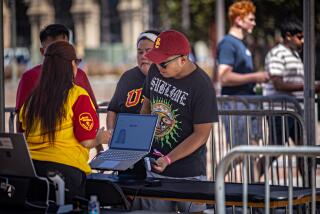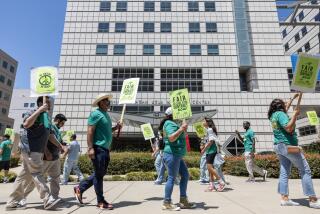Labor Leaders Try to Reignite Activist Spirit at UCLA âTeach-Inâ
Amid protest songs, union chants and a militant mood evocative of the late 1960s, top national and local labor leaders reached out to students at a UCLA âteach-in,â hoping to tap a new era of campus activism.
The program, highlighted by an address by AFL-CIO President John J. Sweeney, reflected the push by organized labor to attract more young people to the union cause.
Labor leaders, drawing on recent polling data, are convinced that young workers and students are more willing than their parents to join unions. Consequently, organized labor is looking to the young--along with minorities, women and immigrants--to rebuild its shrunken ranks.
Teach-ins such as the one held at UCLA on Thursday night and Friday give labor leaders an opportunity to link up with students âwho are extremely affected by the economy and the direction of the country,â said Richard Trumka--second-in-command at the AFL-CIO--who spoke on union organizing at the UCLA program.
âThey see the labor movement as a way to change things they donât like in the country--and theyâre right,â he said.
The UCLA teach-in often was more like a rally than an academic exercise. Many in the standing-room-only crowd in a 425-seat UCLA auditorium Thursday were college activists who came from all over the state.
âSolidarity statementsâ read to the audience in support of garment workers at Guess Inc., Detroit newspaper strikers and California strawberry pickers drew thundering applause.
âIt made me very optimistic about the labor movement,â said William Aviles, a graduate student in political science from UC Riverside.
Aviles said his only objection was organized laborâs relationship with the Democratic Party.
âThe labor movement should put more pressure on the Democrats to get what they want,â he said.
Even non-activists such as Stacy Kim, a 20-year-old UCLA junior majoring in sociology, were impressed.
âIt was great to see everyone so passionate about something, like work, that we take for granted,â Kim said.
Kim said that she still doesnât expect to become active in the labor movement but that she âwill want to learn more aboutâ union issues.
With a host of economic, legal and social factors continuing to drain the ranks of organized labor, only 14.5% of the U.S. work force now belongs to unions, according to government figures.
However, young people âdonât have negative stereotypes about unions, even if they arenât necessarily sold on them yet,â said Guy Molyneux, vice president at the Peter D. Hart Research Associates polling firm in Washington.
A recent labor-financed Hart survey of 1,002 American adults found that in labor-management disputes, 52% of those in the 18-34 age group generally side with labor. The figure was only 30% for those 35 years old and up.
Along with scheduling more teach-ins, the AFL-CIO will try to reach students and young workers through its Union Summer program again this year. That program puts young people to work on picket lines and in other roles in organizing campaigns.
The UCLA teach-in was modeled after a gathering last year at Columbia University in New York. But the bigger Columbia program drew thousands of labor intellectuals and academics, unlike the more youth-oriented UCLA gathering.
Still, at UCLA there were âa lot of people here who can be recruited into the labor movement, which is what these teach-ins should be about,â said Jo-Ann Mort, a New York-based official with the garment industry union UNITE.
In his speech, Sweeney pointed out that AFL-CIO leaders conducted their big annual meeting this week in Los Angeles because of the cityâs recent labor activism. He cited such union battles as pioneering campaigns involving immigrant garment workers at Guess, waterfront truck drivers and office building janitors.
Until this year, AFL-CIO leaders for decades held their meeting at a luxury resort in south Florida and rarely met with ordinary workers struggling to unionize.
Said Sweeney: âHistorically, this has been a fiercely anti-union city. But what we are seeing now is a new fervor a new spirit, a new determination arising from the ravages of the past 20 years.â
More to Read
Sign up for Essential California
The most important California stories and recommendations in your inbox every morning.
You may occasionally receive promotional content from the Los Angeles Times.










